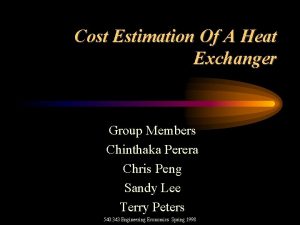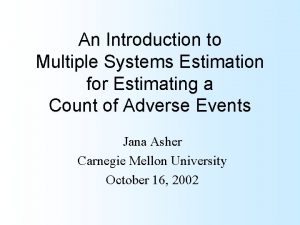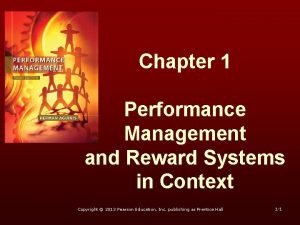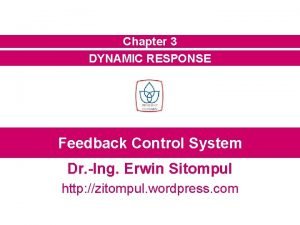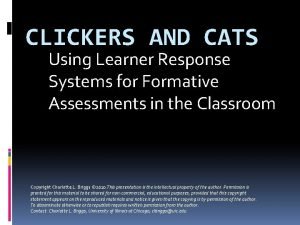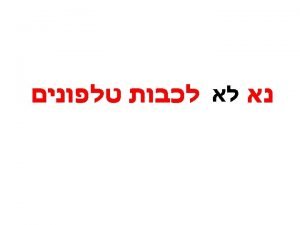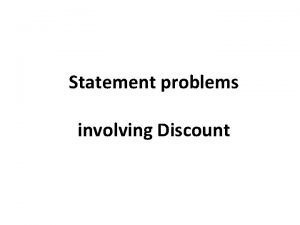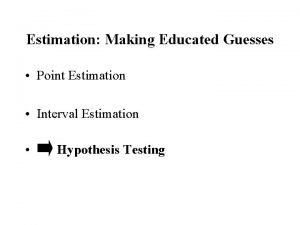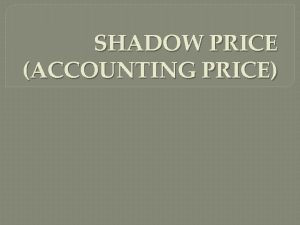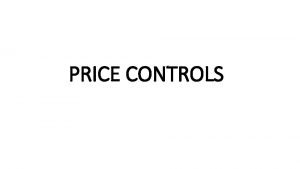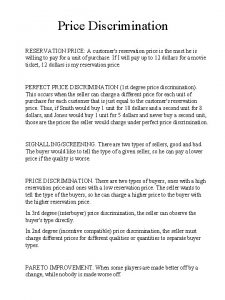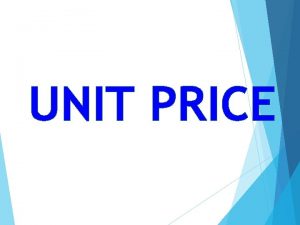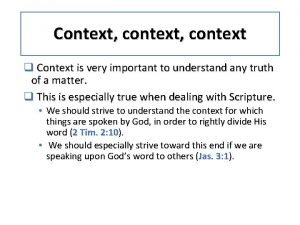Price Response Estimation The Systems Context of Price
































































- Slides: 64

Price Response Estimation

The Systems Context of Price Response Estimation



Information of Managers on Price. Relevant Factors (Self-Evaluations)









Case: Kodak






Case: Lion

Case: Lion


















Inelastic and Elastic Demand






The Dorfman-Steiner Condition l l l The firm is a monopoly. Demand function: Q(P, A), where P is the price and A is the advertising expenditure. Profit function: Π = (P – C)Q(P, A) – A, where C is the marginal production cost. εP: the price elasticity of demand; εA: the advertising elasticity of demand. In the equilibrium, A/Sales = εA/εP.

影響價格彈性的其他因素 l Influence of the Internet on price sensitivity l l The Internet has increased customers’ price sensitivity, e. g. mysimon. com, 手機王. Mckinsey’s study found that there is less pricecomparison shopping taking place on the Internet than is possible: 89% (book), 84% (toy) and 81% (music).

影響價格彈性的其他因素 l l l Asian consumers generally tend to be highly price sensitive and are pragmatic shoppers. One study in south California found that Chinese consumers engaged in more information search on products and prices than U. S. consumers. Price indifference band: 17% (mouthwash), 13% (batteries), 9% (small appliance), and 2% (certificates of deposit).

Consumer Research l l l l Ways of contact Survey research In-depth interviews Focus group Observation research Ethnographic research Diaries Other qualitative methods

Ways of Contact l l Mail: not biased or distorted by interviewers, simple and clearly worded question, low response rate. Telephone: quick, interactive, higher response rate than mail. Personal interview: most versatile, expensive and require more administrative planning and supervision. Online interview: convenient.

Survey Research l l Learn about people’s knowledge, beliefs, preferences, and satisfaction, and to measure these magnitudes in the general population. Best suited for descriptive research Major advantage – flexibility, e. g. Bissell’s Steam’n Clean. Limitations – subject’s language, privacy, incapability, boasting, or cooperation.

In-Depth Interviews l l An in-depth interview is a qualitative method conducted one-on-one using open-ended questions that require the respondents to generate their own answers. The primary difference between an interview and a survey is the interview’s use of an unstructured questionnaire.

Focus Group Research l l l A focus group is a gathering of 6 to 10 people who are invited to spend a few hours with a skilled moderator to discuss a product, service, organization, or other marketing entity. Useful exploratory step Avoid generalizing the reported feelings of the focus-group participants to the whole market.

Focus group research in progress

Outline of Focus Group Interview

Friendship Focus Group l l l Friendship focus group is used in a comfortable setting, usually people’s homes, where the participants have been recruited by the host. This approach is designed to break down barriers and save time in getting to more indepth responses. A self-constructed friendship group was easier to assemble and yielded more honest and candid response.

Observation Research l l Observation research takes researchers into natural settings where they note the behavior of consumers using video, audio, and disposable cameras to record consumers’ behavior at home (with consumer consent), in stores, or wherever people buy and use their products. A market will often use observation in the aisles of grocery, drug, and discount stores to watch people making their product selection.

Examples of Observation Research l l Shoppers often zip through the snack aisle, spending only 42. 7 seconds there, whereas they spend more than twice that in the coffee aisle. Only 34% of shoppers who don’t have baskets actually purchase something, while 75% of shoppers with baskets buy some items. A woman who shops with another woman spends twice as much time in the store than if she shops with a man. Basha’s Market’s greeting cards – 18% → 62% and sales↑ 40%.

Observational Research Fisher-Price set up an observation lab in which it could observe the reactions of little tots to new toys.

Ethnographic Research l l l Ethnographic research involves the researcher in living the lives of the people being studied. Observe consumers in their “natural environments. ” Examples: Sunbeam’s Coleman Grill; Once. Famous.

Once. Famous l l A unique ethnographic laboratory for studying consumer behavior in a natural setting. Some interesting results: man (e. g. Brookstone, Sharper Image) vs. woman (e. g. Pottery Barn); cool colors vs. warm colors; turn left vs. turn right.

Diaries l l Consumers are asked to record their activities through the use of diaries. Pros: (1) catch the consumer in a more realistic, normal life pattern; (2) lead to re-creation of a day in the life of a consumer. It is valuable in media research because they tell media planners exactly what programs and ads the consumers watch. Beeper diaries are used as a way to randomize the recording of activities.

Other Qualitative Methods l l l Cognitive psychologist have learned that human beings think more in images than words. Researchers try through pictures to uncover mental processes that guide consumer behavior. Some scholars believe that the conventional wisdom about consumer research, such as using interviews and focus groups that rely on talking to people and grilling them about their tastes and buying habits, is only good for getting back predictable answers.

Other Qualitative Methods l Methods: l l l l Fill-in-the-Blanks (填空) Purpose-driven Games (目的導向的遊戲) Story elicitation (說故事) Artifact creation (居家事物的描繪), e. g. life collages (生活拼 湊), day mapping (一天生活描述), and construction of instruction books (指導手冊的建構). Photo elicitation (看圖說故事) Photo sorts (照片分類) Metaphors (隱喻)

 Ibang katawagan ng price ceiling
Ibang katawagan ng price ceiling Heat exchanger cost estimation
Heat exchanger cost estimation Batten wiring diagram
Batten wiring diagram Multiple systems estimation
Multiple systems estimation High context vs low context culture ppt
High context vs low context culture ppt High context vs low context culture ppt
High context vs low context culture ppt Linguistic context examples
Linguistic context examples Komunikasi verbal adalah
Komunikasi verbal adalah Natural response and forced response
Natural response and forced response What is natural response
What is natural response A subsequent
A subsequent Performance management chapter 1
Performance management chapter 1 Dynamic response in control systems
Dynamic response in control systems 50 cats by angelo and cross
50 cats by angelo and cross Personal response systems
Personal response systems Hình ảnh bộ gõ cơ thể búng tay
Hình ảnh bộ gõ cơ thể búng tay Frameset trong html5
Frameset trong html5 Bổ thể
Bổ thể Tỉ lệ cơ thể trẻ em
Tỉ lệ cơ thể trẻ em Voi kéo gỗ như thế nào
Voi kéo gỗ như thế nào Glasgow thang điểm
Glasgow thang điểm Chúa yêu trần thế alleluia
Chúa yêu trần thế alleluia Môn thể thao bắt đầu bằng chữ đua
Môn thể thao bắt đầu bằng chữ đua Thế nào là hệ số cao nhất
Thế nào là hệ số cao nhất Các châu lục và đại dương trên thế giới
Các châu lục và đại dương trên thế giới Cong thức tính động năng
Cong thức tính động năng Trời xanh đây là của chúng ta thể thơ
Trời xanh đây là của chúng ta thể thơ Mật thư tọa độ 5x5
Mật thư tọa độ 5x5 Phép trừ bù
Phép trừ bù Phản ứng thế ankan
Phản ứng thế ankan Các châu lục và đại dương trên thế giới
Các châu lục và đại dương trên thế giới Thể thơ truyền thống
Thể thơ truyền thống Quá trình desamine hóa có thể tạo ra
Quá trình desamine hóa có thể tạo ra Một số thể thơ truyền thống
Một số thể thơ truyền thống Cái miệng nó xinh thế
Cái miệng nó xinh thế Vẽ hình chiếu vuông góc của vật thể sau
Vẽ hình chiếu vuông góc của vật thể sau Nguyên nhân của sự mỏi cơ sinh 8
Nguyên nhân của sự mỏi cơ sinh 8 đặc điểm cơ thể của người tối cổ
đặc điểm cơ thể của người tối cổ Giọng cùng tên là
Giọng cùng tên là Vẽ hình chiếu đứng bằng cạnh của vật thể
Vẽ hình chiếu đứng bằng cạnh của vật thể Fecboak
Fecboak Thẻ vin
Thẻ vin đại từ thay thế
đại từ thay thế điện thế nghỉ
điện thế nghỉ Tư thế ngồi viết
Tư thế ngồi viết Diễn thế sinh thái là
Diễn thế sinh thái là Dạng đột biến một nhiễm là
Dạng đột biến một nhiễm là Bảng số nguyên tố lớn hơn 1000
Bảng số nguyên tố lớn hơn 1000 Tư thế ngồi viết
Tư thế ngồi viết Lời thề hippocrates
Lời thề hippocrates Thiếu nhi thế giới liên hoan
Thiếu nhi thế giới liên hoan ưu thế lai là gì
ưu thế lai là gì Hổ sinh sản vào mùa nào
Hổ sinh sản vào mùa nào Sự nuôi và dạy con của hổ
Sự nuôi và dạy con của hổ Sơ đồ cơ thể người
Sơ đồ cơ thể người Từ ngữ thể hiện lòng nhân hậu
Từ ngữ thể hiện lòng nhân hậu Thế nào là mạng điện lắp đặt kiểu nổi
Thế nào là mạng điện lắp đặt kiểu nổi Marked price-selling price=
Marked price-selling price= Difference between hire purchase and installment system
Difference between hire purchase and installment system Define strategic sourcing
Define strategic sourcing Price discovery and price determination
Price discovery and price determination Decision support systems and intelligent systems
Decision support systems and intelligent systems Dicapine
Dicapine Embedded systems vs cyber physical systems
Embedded systems vs cyber physical systems Elegant systems
Elegant systems

